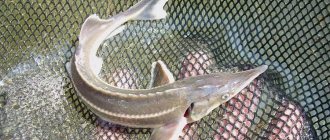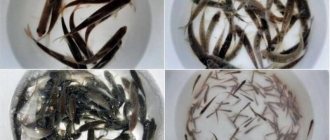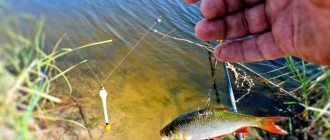Sterlet: how to clean and cut up at home
Even today they make stroganina from it, smoke it, and use the insides, the same chord and caviar, for exquisite fish cutlets and fillings in pies. Even the hero of Louis de Funès sang a song in one of the films, mentioning “a piece of sterlet.”
But how to gut fish correctly so as not to damage the valuable meat, but also not cause harm to health?
Cutting methods directly depend on what kind of dish you need to prepare, maintain the integrity of the fish skin or cut the fillet in portions. They buy whole sturgeon in stores. You can catch sterlet, but remember that it is listed in the Red Book of Russia.
Frozen sterlet: how to remove mucus and clean it
Frozen fish is easier to clean
- Cut off the head along with the fins.
- Holding the tail, place the fish vertically and cut off the spines along with the fins.
- Remove the skin by prying from one edge. Sterlet is a very oily fish, so the skin does not harden into stone when frozen and is easy to remove.
- Then proceed in the same way as when cleaning fresh fish.
How to properly clean frozen fish: video
Preparing cleaned fish depends on the dish you are going to prepare.
Cleaning fresh fish
Fresh sterlet has a maximum of valuable substances and high taste, so it is better to clean freshly caught or store-bought live fish. There is no need to kill it before cutting: just leave the sterlet in the air and wait until it stops fluttering.
Instructions for cutting sterlet step by step:
- Sterlet, unlike scaly fish, does not require complex surface treatment. Her skin is only cleaned of mucus. You can remove all excess with a napkin or rub the carcass with coarse salt and then wash it under the tap.
- Carefully, so as not to get hurt, cut off the top and side “bugs”. To facilitate the process, you can first scald the fish with boiling water.
Tip: The sides of the spikes can be cleaned with a medium vegetable grater.
- The head is cut off along with the fins. You shouldn’t throw it away: you can make a rich fish soup from this part of the sterlet. However, the head spoils too quickly at room temperature, so it needs to be put in the freezer or sent to boil, after removing the gills and eyes.
- To clean the skin, the fish is also doused with boiling water. The skin is lifted at the top and pulled towards the tail.
- The belly of the sterlet is cut open and all the entrails are removed. The gall bladder is removed carefully so that its contents do not get on the meat, otherwise it will become bitter.
- Cleaned sterlet is washed under running water.
- Next, take out the vizig. To do this, cut the carcass from the inside at the tail and at the head, pick up the chord with a knife or hook and carefully pull it out. If the fish is large, you can make more cuts.
What you need for cutting at home
- sharpened knife;
- cotton or rubber gloves;
- cutting board;
- coarse salt;
- water.
It is important that the knife is well sharpened. The fact is that the skin of this fish is very tough and rough. Without a sharp knife, you won’t be able to cut and peel it.
Quite often, sterlet is sold in stores alive directly from the aquarium. If this is your case, the fish must first be euthanized. Put it in the freezer for several hours or let it fall asleep in the air. Frozen fish is easier to clean.
Fresh sterlet: how to cut and gut
To make cutting easier, you first need to get rid of the mucus. To do this, rub the skin with coarse salt and then rinse with lukewarm water. You don’t have to do this, but simply use cotton gloves. Cotton will absorb mucus, and you will not get hurt by sharp thorns - bugs.
- To prevent the fish from slipping out of your hands during cleaning, it is better to wear special gloves. You can also use a paper towel or piece of newspaper.
- Mucus can be removed by wiping the carcass with a napkin or rubbing with coarse salt, and then rinsing under running water.
- If you decide to clean the sturgeon on the table, cover it with several sheets of newspaper and change them as they become dirty.
- The skin that turns white after scalding is very easily removed with a brush for washing vegetables. You just need to “clean” the fish, like you peel potatoes before baking them in their “jacket”.
- You need to clean the fish away from you to avoid injury.
- When cutting the belly, you must be extremely careful not to damage the gallbladder. If the liquid that fills the bubble gets on the meat, it will become bitter and unfit for consumption.
- Always cut out the gills if leaving the head. With them the dish may become bitter.
- Don’t be lazy to take out the vizig if you want the dish to look attractive. It can be dried and used in the future. In this form it is stored for a long time.
- If there is caviar in the belly, it can be salted and later used for making pates or as an independent dish.
- Milk can also be salted, but it must be used as quickly as possible. In air, their taste deteriorates due to fat oxidation.
- Cartilage and strips of skin with bugs can be used to prepare broths and jellied fish.
- It is better to cut out places with bruises and damage on the sturgeon’s body.
- Many people believe that it is easier to clean frozen fish. But, naturally, it will no longer be as tasty as fresh. Therefore, it is better to clean freshly caught fish immediately, but first you need to let it sleep in the air. Step by step this procedure will look like this:
- The first step is to clean the fish from the mucus covering its body. You can simply wipe it with a napkin, but it will be much easier to do this if you generously sprinkle the carcass with coarse salt, leave for 15 minutes and then simply wash in lukewarm water.
Next, you need to use a sharp knife to cut off the top row of bugs along the entire length.
How to keep fish fresh when fishing
Keeping fish fresh, fit for consumption, for a long time during fishing and transporting it home is not much easier than catching it. This is especially true during the hot season. What to do if you don’t have a portable refrigerator at hand, but the sun is beating down mercilessly and the water is very warm. After all, eating spoiled fish is extremely dangerous to health. Here are some useful tips on how to preserve your catch in the summer.
First, let's look at what signs indicate that the fish has gone bad:
- strong unpleasant odor;
- clouding of the cornea of the eyes, whitish color of the eyes, eyes drooping inward;
- the dark red gills of the fish first turn pale, and then become white and covered with a layer of mucus;
- the belly of a large fish swells, while a small one may burst;
- the skin tears easily, the meat begins to separate from the bones and softens
Such signs clearly indicate that this fish can no longer be eaten! Conversely, fresh, edible fish has the following characteristics:
- the body of the fish should be elastic and if you lightly press your finger on the skin, the depression will quickly disappear;
— the smell of fresh fish is light, slightly reminiscent of cucumber;
— the scales hold well, do not peel off, and have a clean and shiny appearance;
— gills are dark red (in frozen ones they are gray-red);
- eyes are bulging and transparent.
But if you are not going to prepare the entire catch immediately upon returning to shore after fishing, you need to take care of its safety almost immediately after each specimen is caught. Ideally, if the water is not too warm and the fish can be removed from the hook without significant damage, it can be kept in a spacious cage for the rest of the fishing trip. You should remove it from the hook as carefully as possible so that it remains alive as long as possible. In this case, they use various devices: gappers, extractors, tweezers.
It is advisable to choose a cage as large and long as possible if fishing occurs from the shore. In this case, the fish has the opportunity to go down to the end of the cage, into the coolest and cleanest water. The cage must be kept in the shade under a tree or bushes; you can use a small awning if there is no natural shade. To sink the far part of the cage into depth, you can attach a removable weight of 0.5 - 1.0 kg to the last hoop. The cage cell made of synthetic thread must be small so that the fish cannot stick their head into it and suffocate. When fishing from a boat, you can use cages that are shorter but wide enough. You should not use metal cages - the fish in them quickly die, hitting the wire. And of course, do not put caught fish in plastic bags - this way they die almost instantly, and dead fish, due to the presence of a large number of bacteria in the water, begin to deteriorate immediately. Therefore, fallen fish should be immediately removed from the cage and processed to preserve freshness using one of the methods described below.
Large, strong fish, if they have not received serious damage during fishing, are convenient to keep on a kukan. The simplest kukan can be made yourself from thick, 1.0-2.0 mm monofilament fishing line, threading the ends of the line under the gill and out through the mouth. But much more convenient are kukanas made of soft metal cable with separate fasteners. On such a kukan, large pike, catfish, carp, and crucian carp can remain alive for 2-3 days even in the summer.
However, it should be remembered that some types of fish are quite tenacious and die immediately after being caught. These species include Caspian herring, blue bream, silver bream, and sabrefish. In addition, the perch practically does not live in the cage, as it swallows bait and bait greedily, being severely damaged when the hook is removed.
If the fish has fallen asleep in the cage or it is impossible to keep it alive for other reasons, the live fish should be killed (pinned) immediately after catching and then processed, observing the following rules:
— killed fish tastes better than dried fish and lasts much longer;
- large and medium-sized, weighing more than 1.0 kg, specimens should be bled. To do this, without gutting the belly, you need to make a deep incision along the spine near the tail from below (the blood accumulates in the fish in special sinuses under the ridge inside the ribs). Next, hold the carcass with the tail down so that most of the blood drains out;
- remove the gills, as they begin to deteriorate first and poison the rest of the meat;
- You can quickly kill a fish by piercing the brain with an awl. To do this, having securely fixed the body, sharply insert the tip from the base of the head from the back towards the mouth. It is better to stun very large specimens, for example, catfish or carp, with a blow to the head. You can break the base of a pike's spine if you force the head back toward the back with a sharp movement until it cracks;
- fish prepared in this way should be wrapped in grass with a low moisture content. Sedge, mature nettle, and reed leaves are perfect for this. The carcasses are wrapped in grass, stuffed into the mouth and kept separately for some time in the shade in the breeze so that the mucus on the surface of the body is aerated - this is a kind of preservative film that protects the meat from spoilage by microbes;
- if you don’t have grass on hand, you can use a cotton or linen cloth, or even thick paper, slightly moistened in any vinegar (table, wine, apple);
- after this, it is enough to place the carcasses wrapped in grass in a basket, nettle bag or lattice container and then store in the shade and as cool as possible;
- during such storage, fish should be protected from flies, since the blowfly tries to deposit its larvae on the skin of the fish - maggots, which quickly penetrate the peritoneum and gills, and fish damaged by maggots quickly spoils and is not suitable for food;
- if it is very hot, it is better to play it safe - remove the gills, gut and salt the abdominal cavity. In this case, you should not wash the carcasses, but it is better to immediately wrap them in grass.
In addition, if you have to store fish for more than a day, and there is no cool place, you can use the old method - dig a deep, at least 1 m, narrow hole in dry sandy soil. At such a depth, the temperature in the middle zone, even in summer, does not rise above +12+15 degrees C. The bottom of the pit is lined with a layer of reeds, reeds, and sedges, then fish carcasses wrapped in grass are placed. After checking, the fish is covered with a layer of dry grass and covered with soil. In such an improvised refrigerator, fish and raw meat can remain fresh for up to 3 days, even in extreme heat.
It is also useful to know that many natural food preservatives, such as garlic, vinegar, mustard, and nettle leaves, significantly extend the shelf life of fish due to the content of acids and essential oils that are harmful to bacteria.
We recommend reading: How to Soak Porcini Mushrooms
Remember that fish should be stored in containers with good air circulation and not allowed to soak. Do not place fish carcasses wrapped in grass and burlap too tightly - they must be ventilated.
It is very important to remember that in the process of preparing freshwater fish you should carefully follow the technology and recipe and under no circumstances eat fish products prepared by someone unknown, how and when! This is due to the fact that river and lake fish, especially predators (pike perch, pike, perch, ide), are one of the intermediate hosts in the development cycle of some parasites dangerous to humans. Therefore, you should not eat raw fish, lightly salted and lightly dried. Do not eat lightly salted pike caviar that has not undergone heat treatment. And of course, you shouldn’t drink raw water at all, especially from stagnant bodies of water.
The larvae of parasites die when fish meat is boiled for more than 20 minutes, or frozen for more than 3-4 days at temperatures below -18 degrees Celsius. and when salted in strong brine for more than 3 days. Keep in mind that the larger the pieces and carcasses of fish, the longer the processing should be.
Well, if you follow these simple rules for storing and preparing fish delicacies, all you have to do is enjoy your favorite delicacy without any fear for your health.
Have a good bite on Akhtuba and bon appetit!
- if you don’t have grass on hand, you can use a cotton or linen cloth, or even thick paper, slightly moistened in any vinegar (table, wine, apple);
Removing vizig through the tail
Not every fisherman or housewife knows what sterlet viziga is. This part must be disposed of before cooking: it contains substances that are toxic to the human body.
It is easy to get rid of by making an incision in the area of the caudal fin. To do this, you need to cut off the tail fin using a sharp knife or culinary scissors. After this, you should pry off the white vizig with a thin blade or large needle. Then you need to pull out the poisonous organ. You can use pliers for this. Movements should be careful and smooth.
If the vizig was damaged during removal, the poisonous contents leaked out, it is necessary to thoroughly rinse the meat.
How to clean sterlet and cut it up for preparing various dishes
Sterlet has long been considered a delicacy fish and was often served at the royal table. They used it to make fish soup, smoke balyki, bake whole fish, fry it, make jelly, bake pies with it, and prepare many other dishes. In the times of Peter the Great, sterlet was even specially bred in ponds so that the tsar could have this tasty and valuable fish on his table at any time. It takes some effort to clean and cut the fish, but we are not afraid of difficulties, right?
What kind of animal is this fish?
Sterlet belongs to the sturgeon family, although it is slightly different from them. Compared to other sturgeon, it matures earlier, lives less and is smaller in size. But this cannot be attributed to its shortcomings; sterlet meat is perhaps the most delicious of all its relatives.
Sterlet is a valuable delicacy fish
Sterlet meat is rich in vitamin PP, unsaturated fatty acids Omega 3, microelements that help improve blood circulation and brain activity, restore vision, reduce the risk of cardiovascular and even cancer. Moreover, its calorie content is only 90 calories per 100 grams. This makes sterlet not only a very healthy product, but also a dietary one.
This fish is easily distinguished by its long narrow nose and fringed mustache reaching to the mouth. There are no scales, but there are 5 rows of bony scutes: along the edges of the belly, on the sides and closed in the center of the back. Between the rows of scutes the skin is either bare or covered with bony plaques.
Sterlet has no bones. Instead, a cartilaginous ridge runs along the entire body, in the cavity of which the vizier is located, it is also called the notochord.
Viziga is a sinewy fabric in the form of a bubble rope. It is believed that if a fish falls asleep in the air, cadaveric poisons begin to be released from the vizig, which can spoil the meat and make it unsuitable for eating. Therefore, experienced fishermen in the summer immediately remove the vizig from freshly caught fish. With quick freezing, this does not happen. With appropriate processing, viziga is edible and even very tasty.
This structure of the fish determines the features of its cleaning and cutting.
So, in front of you lies the miracle Yudo fish, sterlet, covered with mucus and rows of spines, and you are already looking forward to a delicious lunch. But first, the fish needs to be cleaned, gutted and cut up.
What you need for cutting at home
- sharpened knife;
- cotton or rubber gloves;
- cutting board;
- coarse salt;
- water.
It is important that the knife is well sharpened. The fact is that the skin of this fish is very tough and rough. Without a sharp knife, you won’t be able to cut and peel it.
Quite often, sterlet is sold in stores alive directly from the aquarium. If this is your case, the fish must first be euthanized. Put it in the freezer for several hours or let it fall asleep in the air. Frozen fish is easier to clean.
Fresh sterlet: how to cut and gut
To make cutting easier, you first need to get rid of the mucus. To do this, rub the skin with coarse salt and then rinse with lukewarm water. You don’t have to do this, but simply use cotton gloves. Cotton will absorb mucus, and you will not get hurt by sharp thorns - bugs.
Using a sharp knife, cut off the dorsal bugs along with a strip of skin, starting from the tail. The lateral and periventral bugs can be cleaned off with a knife, like ordinary scales, or cut off in the same way as the dorsal ones. At the same time, the fins are cut off.
The cavity is washed well with cold water, freeing it from blood clots along the ridge line, films and remnants of the air bubble.
We rip open the belly and remove the entrails
The belly is opened starting from the anus and all the insides are removed. Do not rush to throw away the entrails, some of them are quite suitable for food. If caviar is found in the fish, it can be salted, freed from the film, or cooked together with the fish.
Remove the vizig. To do this, cut the tail and make an incision at the junction of the body with the head, trying to cut only the cartilage without damaging the viz. Pick up the vizig with a stick or crochet hook and carefully pull it out, trying not to tear it. If you still cut the chord, use pliers. Or make a cut along the entire ridge and remove the chord by lifting it with a fork.
The head can be cut off or left, it depends on the dish that will be prepared. In both cases, the gills are removed. The head can also be used separately; it makes a wonderful ear.
If you need to remove the skin, it is scalded with boiling water and removed from head to tail. If this is not done, it will be very difficult to separate the skin from the tender meat; it will be removed along with it. In the finished dish, the skin itself is easily separated.
Detailed instructions on the steps in the video
Advice! Do not rush to throw away “production waste”. Skin, fins and even bugs make good fish soup or broth for aspic.
From the head, tail, skin and thorns you can cook a delicious fish soup
If you received a frozen specimen or you brought the sterlet to this state yourself, cleaning becomes much easier.
Frozen sterlet: how to remove mucus and clean it
Frozen fish is easier to clean
- Cut off the head along with the fins.
- Holding the tail, place the fish vertically and cut off the spines along with the fins.
- Remove the skin by prying from one edge. Sterlet is a very oily fish, so the skin does not harden into stone when frozen and is easy to remove.
- Then proceed in the same way as when cleaning fresh fish.
How to properly clean frozen fish: video
Preparing cleaned fish depends on the dish you are going to prepare.
Preparing to cook
For fish soup
The skin is removed and the fish is cut into portions. Often other fish are added to sterlet fish soup; sim and burbot are the best.
If you use a sterlet head, you need to cook it within 1-2 hours after cutting, otherwise it will spoil.
For frying, kebabs
Separate the meat from the cartilage and cut into portions. Use a very sharp knife, otherwise tender fatty meat will not be able to be cut accurately.
Interesting: How to Preserve Cauliflower for the Winter at Home
Sterlet cartilage is edible and very tasty; it can be added to fish soup or aspic. When cooked, the cartilage softens.
Smoking and baking
In this case, there is no need to skin and cut off the head and tail. The fish is cooked whole, the skin is easily separated from the finished meat.
Steaks
The cartilage is not removed, but the skin must be removed. The meat is cut into slices 1.5-2 cm thick.
Stroganina
For stroganina, the fish is cleaned and cut, but not defrosted. If the carcass is large, first cut it into several pieces, and then cut them into thin slices.
How to cut sterlet for planing: video
Advice! If you want to make minced sterlet, simply chop the tender flesh with a knife. There is no need to use a meat grinder, it will only crush the meat.
Some tips
- to get rid of mucus, rub the carcass with coarse salt and then rinse with slightly warm water;
- be sure to remove the vizig, otherwise the meat will become inedible and hazardous to health;
About 5 years ago I made fish soup. Everything is according to the “classics”: first the roach, crucian carp and bream. Then a couple of small carp, about a kilogram each. After that, 2 sterlets, about a kilogram each (we specially went to the nursery and brought them alive, taking crushed ice). I didn’t delete Vyaziga: no matter how much I tried to figure out where it was, I couldn’t. The hot one had a good taste, although with some strange tint. Knowing that if it sits, it will taste much better cold, so I left it overnight. And it was fatal: I’ve probably never tried such strychnine in my life.
Popovich Alexey
- so that the skin can be easily removed, pour boiling water over the carcass or freeze it;
- bugs can be easily removed without the help of a knife if you hold the fish in hot water for a few seconds and then remove them with twisting movements;
- Before cooking, pour boiling water over portioned pieces, this will help maintain their shape.
Sterlet is a fish that is difficult to spoil when cooking. She is good in any form. The main thing is not to overdo the salt and pepper, and, of course, to clean and prepare it properly. Armed with the knowledge you have acquired, you will do this with ease, and a royal dinner is guaranteed for you.
Frozen sterlet: how to clean it properly?
If sturgeon species are frozen first, the cleaning process will become faster and easier. If you plan to cook the fish in portions, and the appearance of the skin is not important, use “grandmother’s methods”:
- The frozen sterlet is dipped into hot water during the boiling period for 2-3 minutes - and the skin is removed with a stocking along with the spines, just remember to make cuts on the belly or near the head and tail.
- In a thawed carcass, the chord is removed; it is toxic. If it is damaged and the contents end up on the fillet, you will have to discard the fish.
- If sturgeon are cleaned in advance for cooking in batches, you can immediately cut the cleaned carcass - cut into pieces, which are treated with basic seasonings and lemon juice, and frozen. So, taking the finished steaks out of the freezer, send them to the grill or oven.
Processing for fish soup
There are many ways to process sterlet for fish soup: from primitive camping to complex restaurant cooking. In any case, be sure to remove the entrails and gills. It is also better to remove the mucus, although in camping conditions it is left in place so as not to mess around with it too much.
Processing sterlet for fish soup
At home or on the go, simply cut the processed sterlet into large pieces and cook the fish soup. In a professional kitchen they do this:
- The head and tail are cut off.
- The sterlet is cut along the vertebral chord into fillets with or without skin.
- The first broth is prepared from the head, tail and vertebral chord.
- Portioned pieces are cooked in this broth, resulting in double fish soup with a richer taste.
Sterlet soup
This method is more complicated than homemade, but the finished fish soup turns out tastier and more aromatic with the same amount of fish.
A little about sterlet. Features and nutritional value
On sale you can find sterlet 1 kg or more. But its maximum live weight can be up to 30 kg. River fish lives only in clean water, so its meat is considered the most delicious and healthy.
Sterlet is distinguished by the characteristics of its habitat:
- A running fish is a fish that moves along the river. You can distinguish it by its appearance: a sharp elongated snout, a long narrow body. This variety of sterlet contains less fat, it has lower calorie content, but when cooked it is slightly dry.
- The sedentary variety has a blunter nose and a plump body. This is a fattier variety of sterlet than the popular variety.
The skin of the fish is bare, has no scales, but is covered with dense mucus. There are rows of hard bug plaques on the back and sides that must be removed before cooking.
The peculiarity of cartilaginous fish is the absence of bones. They don’t even have a spine; it is replaced by a cartilaginous cord running in the upper part of the body, above the peritoneum. Inside this formation there is an elastic tissue called vizig. It is believed that the sterlet's vizig should be removed immediately: it is impossible to store the carcass without removing this tissue. If it is not possible to quickly process the fish by removing the fish, then it must be frozen, sometimes even alive. In this case, you will have to clean the sterlet immediately after defrosting.
The nutritional value of fresh fish is 120-122 kcal/100 g. Sterlet meat contains about 18% protein, which is easily and completely absorbed in the human body. The average fat content is approximately 6% and depends on the type of fish. Due to its low fat content, sterlet meat is considered dietary.
In addition to protein and fat, meat has a valuable composition, including rare microelements: molybdenum, nickel, fluorine. Sterlet contains a large amount of unsaturated omega-3 fatty acids, which are beneficial for the normal functioning of the heart and blood vessels. In addition to them, fish contains vitamin PP and several B vitamins necessary for people.
How and where to store sterlet correctly?
Sterlet storage is not difficult. The key point in this case is to avoid weathering and eat fish as soon as possible after purchasing or defrosting it. You can buy sterlet chilled or frozen. In rare cases, it can be sold live.
Nuances of storing sterlet:
- Opened sterlet cannot be frozen or stored in the refrigerator (any fish should not be stored at room temperature for more than a few hours);
- if the sterlet has been fresh on the table for several hours, then it must be cooked (in this case, the fish is no longer suitable for further storage in the refrigerator or freezer);
- Sterlet should be stored in the refrigerator in containers, pans or other containers with lids (polyethylene cannot be used as packaging);
- sterlet is well stored in ice (the fish can be laid out on a tray with ice, covered with a towel on top or sprinkled generously with crushed ice);
- It is better to preserve the juiciness of chilled sterlet using salted water (the water should not be too salty, otherwise the fish will be difficult to eat);
- if you lightly lubricate the surface of the sterlet with vegetable oil, it will retain its juiciness and tenderness throughout the entire storage period;
- Sterlet should not be stored close to other food products (any fresh fish quickly absorbs foreign odors and spoils);
- You should never store fresh, salted or smoked fish nearby (after a short period of time, all of these products will begin to deteriorate);
- if you pour sterlet with a marinade based on onions, water and vegetable oil, the fish will remain juicy and aromatic for 2 days;
- cleaning sterlet before storage is a stage chosen at individual discretion (some prefer not to clean the fish during frying, and then remove the skin along with the scales);
- Only gutted fish can be stored refrigerated or frozen (sterlet with entrails is not frozen, otherwise the fish may begin to taste bitter after defrosting);
- store sterlet in the same container with other varieties of fish (even if all fish belong to the category of river or only sea inhabitants, the tendency to weathering will always be different);
- If a coating of any shade appears on the surface of the sterlet, the skin becomes sticky, and the smell acquires an unpleasant tint, then you should refuse to store and eat such fish.
If you plan to purchase fish in advance, you can extend its shelf life using a special preparation. Salt water should be frozen in bags or containers. The result will be a kind of salty ice. It is in this preparation that the fish will remain fresh longer and will not lose its traditional taste characteristics.
Dishes for the festive table
For a special celebration, housewives usually choose dishes that they cannot prepare every day. For example, you can serve sturgeon or sterlet at the New Year's table. How to clean and cut such fish? Well, remove the “bugs”, vizig, entrails and gills. What's next? Here everything depends on the imagination of the cook.
Firstly, you can simply wrap the prepared carcass in foil along with lemon and onion, and then place it on a baking sheet and put it in the oven for 50 minutes. It is better to set the temperature to 200-210 degrees. Then unfold the foil and return the fish to the oven for another 10 minutes. Now the finished product can be placed on a dish and decorated.
The skin of such fish is removed with one movement of the hand, and anyone can easily take the meat with a regular fork. Secondly, a good option for the holiday would be a sterlet steak. To do this, you first need to remove the skin from the cleaned carcass. Then marinate the meat with onions, spices and lemon, and then place it on the grill and cook until done in 5-7 minutes. An excellent option, considering that time, which is always in short supply, will require very little, and the result will certainly please all guests.
How to Keep Sterlet Fresh
Fresh fish is a perishable product. Fish caught from water will quickly die when exposed to air. At this time, the fish is called snuly and is considered fresh. After the fish has fallen asleep, it goes through the stage of rigor, that is, it loses its elasticity and hardens. Then, under the influence of enzymes, the tissues of its muscles soften, and subsequently, under the influence of microorganisms, they disintegrate, up to the spoilage of the meat. To prevent this from happening too quickly, you can try to delay the onset of rigor rigor. In different species of fish, rigor rigor begins at different times after the fish are exposed to air. It depends on what species the fish belongs to and what environment it lives in. Thus, marine species - mullet, mackerel, chirus, horse mackerel, anchovy and others - are delicate fish, and rigor rigor when stored in air occurs within a few minutes after catch. It is possible to keep these types of fish fresh only if the entrails and gills are removed from them immediately after the catch, and the fish itself is thoroughly washed of blood with sea water. In this case, rigor mortis may occur several hours later and continue throughout the day if stored in the cold.
We recommend reading: How to Preserve Summer Apples Longer
In river fish - crucian carp, bream, roach, pike perch, carp, sterlet, pike, burbot and others - rigor does not set in so quickly, so it is much easier to keep them fresh.
There are several ways to keep fish fresh for a certain period of time:
• Fish is preserved well when it is killed by hitting it on the head with a wooden mallet. After this, it should be placed in a basket in a thin layer and stored in the shade in a ventilated place, and covered on top with a clean, wet rag.
• To preserve fresh fish for a short period of time - no more than a day - it must be washed, drained, placed in a glacier directly on the ice and covered with a clean rag.
• For longer storage - up to 2 days - the fish should be placed in a loose box or basket (to drain melt water) and sprinkled with clean, finely crushed ice in an amount of 40-50% of the weight of the fish. Laying is done as follows: crushed ice is poured into a 10 cm layer at the bottom of a box or basket, fish is placed on top of it depending on its size in 2-3 rows, then again the same layer of ice and 2-3 rows of fish and, finally, a layer of ice thick up to 20 centimeters.
• To preserve fish for up to 7 days, ice-salt mixtures should be used. With this method, the temperature of the fish can be brought to -8 °C depending on the ratio of salt and ice, which can range from 2 to 10%. With this method, fish can be stored for 7 to 15 days, depending on its quality and outside temperature. Fresh frozen fish. To keep fish fresh, you can freeze it. In this case, I mean a possible situation when fresh fish needs to be preserved before salting or smoking.
The need for this may arise for a fisherman whose catch is small and he is forced to store it until there is a sufficient amount of fish. Of course, storing fish in a household refrigerator without changing its quality will not work. The easiest way to freeze fish is in winter during ice fishing, when the outside air temperature is at least 15 ° C - at this temperature the fish freezes quite quickly. To do this, the caught fish is placed in one layer on ice cleared of snow. When the fish freezes, it is packed in a tight, sealed box. To do this, sawdust is poured into the box, covered with a clean cloth, then the fish is placed, covered with a cloth and covered with sawdust. Store the box with fish in a cold room. At other times of the year, it is more advisable to freeze fish in a quick freezer - there it also retains its original taste.
Ideally, the path of fish from the pond to the freezer should look like this. First, the fish caught with a fishing rod is placed in a cage, where it remains alive for as long as possible, then it is killed just before heading home by the shortest route. You can, of course, use a special cooler bag to transport fish, but then you need to keep in mind that the maximum transportation time should not be more than 8 hours: despite the insulation of the walls, the internal temperature of the bag begins to gradually compare with the outside. The further safety of the fish should be taken care of immediately upon arrival home, and not the next day after the fish has been in the refrigerator at 4 ° C or the freezer at an insufficiently low temperature. The fish brought home must be very carefully gutted and scaled, as described above. The mucus must be washed off under a strong stream of cold water. Then the fish must be wiped and immediately placed in the freezer. Freshly caught fish should not be “rested”: the faster it is frozen, the higher its quality will be. Another prerequisite for high quality frozen fish is the speed of freezing to the lowest temperatures. The required temperature inside the fish, equal to at least -18 °C, and preferably -30 °C, must be achieved as quickly as possible. Each carcass should be placed in the refrigerator separately, or better yet, hung. Then each of them can quickly freeze. This way you can get the perfect quick-frozen fish product. And believe me, these extra efforts will result in better quality salted or smoked fish.
Pay attention! Before any freezing, the fish must be in perfect condition - the carcasses must be processed very carefully before this stage, avoiding any mechanical damage. I’ll tell you a secret, if all the technological operations of freezing, defrosting and then salting and smoking the fish were carried out correctly by you, then even the most sophisticated gourmet will not be able to distinguish the taste of your dried or smoked fish from similarly prepared fresh fish.
Ideally, the path of fish from the pond to the freezer should look like this. First, the fish caught with a fishing rod is placed in a cage, where it remains alive for as long as possible, then it is killed just before heading home by the shortest route. You can, of course, use a special cooler bag to transport fish, but then you need to keep in mind that the maximum transportation time should not be more than 8 hours: despite the insulation of the walls, the internal temperature of the bag begins to gradually compare with the outside. The further safety of the fish should be taken care of immediately upon arrival home, and not the next day after the fish has been in the refrigerator at 4 ° C or the freezer at an insufficiently low temperature. The fish brought home must be very carefully gutted and scaled, as described above. The mucus must be washed off under a strong stream of cold water. Then the fish must be wiped and immediately placed in the freezer. Freshly caught fish should not be “rested”: the faster it is frozen, the higher its quality will be. Another prerequisite for high quality frozen fish is the speed of freezing to the lowest temperatures. The required temperature inside the fish, equal to at least -18 °C, and preferably -30 °C, must be achieved as quickly as possible. Each carcass should be placed in the refrigerator separately, or better yet, hung. Then each of them can quickly freeze. This way you can get the perfect quick-frozen fish product. And believe me, these extra efforts will result in better quality salted or smoked fish.











